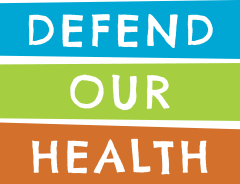4 Ways Plastic Bottles Harm Us In Our Day-to-Day Life
October 23, 2023 | Climate Friendly Solutions, General Updates, Uncategorized | Tags: Defend Our Health, environmental health, Environmental Justice, forever chemicals, Toxic Chemicals
Plastic bottles are everywhere, from soda bottles to hair care products. As consumers, we tend to only think about plastic bottles once we discard them, with constant reminders of: “Don’t forget to recycle!”
But do we really know how plastic bottles impact us in our day-to-day lives? Here are four essential ways:
1. TOXIC CHEMICALS INSIDE OF PLASTIC SODA BOTTLES
We know that plastic bottles contribute to plastic pollution heavily. Many states across the country prioritize recycling as a way to combat that. But that’s once you’ve used the plastic bottle. What if that same plastic bottle has been harming you, even before it was empty?
In Defend’s recent report titled Hidden Hazards: The Chemical Footprint of a Plastic Bottle, we reveal the threat to human health, environmental injustice, and climate change. In our work to develop the report, we discovered that PET plastic, a commonly known plastic used in plastic bottle production, can often contain antimony and cobalt. Antimony is one of at least 150 chemicals (woah!) that can escape from the 100 billion bottled beverages made by U.S. beverage companies each year.
The consumption of antimony has been linked to cancer and toxic effects on the organs, such as the liver. Communities of color face greater exposure to antimony than white populations, with nearly double the exposure in some geographical areas.
2. TOXIC EMISSIONS FROM PLASTIC PRODUCTION
In low-income, communities of color across the US there is an industrial plant in their neighborhood, or even behind their house, that is constantly spewing emissions into the air. These toxic emissions are in part, a result of plastic production.
What is that emission called? Ethylene Oxide (EtO).
50% of all EtO production in the US is connected to the PET supply chain. This exposure impacts three million people daily and is largely concentrated in the Gulf Coast. The health impacts are elevated cancer risk, including breast cancer, lymphoma, and leukemia.
Black and Latinx communities represent 64% of all US residents who face serious cancer risk from living within six miles of EtO emissions from chemical manufacturing plants, while 41% of the U.S. population as a whole are people of color.
3. WATER POLLUTION DUE TO PLASTIC PRODUCTION
Access to fresh water is becoming a scarce commodity even in the United States. We’ve seen cases from Flint, Michigan to Maine impacting communities’ daily way of life for the worse.
The production of PET plastic resin and polyester by petrochemical companies releases a cancer-causing chemical called 1,4-dioxane – a “forever chemical” that the US EPA designates as a likely carcinogen – to groundwater, drinking water, and air than any other industry.
Wastewater discharges of 1,4-dioxane from PET plastic plants pollute drinking water sources in the Ohio River Valley and Southeast United States. Many people rely on rivers as a drinking water source and cannot afford to have their supply consistently polluted.
4. MICROPLASTICS IN FISH
If you like to eat fish, we apologize in advance for the bad news.
Fish are opportunistic feeders and tend to eat objects in the water that resemble their food. Because of this, fish consume an unhealthy amount of microplastics that can be present when we eat them. A good rule of thumb is that you should always clean the digestive trap of the fish before you consume it. Unfortunately, this cannot be applied to smaller fish that are consumed whole, such as anchovies. Microplastics enter our bodies and end up in our digestive tract. Exposure to microplastics can have serious health consequences such as digestive disorders and even poisoning.
